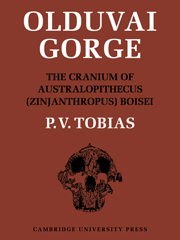Book contents
- Frontmatter
- Contents
- List of text-figures
- List of plates
- List of tables
- Introductory Note
- Foreword
- Editor's Note
- Acknowledgements
- I Introduction
- II Preservation and reconstruction of the cranium
- III The cranial vault
- IV The basis cranii externa
- V Certain critical angles and indices of the cranium
- VI The interior of the calvaria
- VII The thickness of the cranial bones
- VIII The endocranial cast of Zinjanthropus
- IX Metrical characters of the calvaria as a whole
- X The structure of the face
- XI The pneumatisation of the Zinjanthropus cranium
- XII The dental arcade and the palate
- XIII The pattern of dental attrition and occlusion, with comments on enamel hypoplasia
- XIV The size of individual teeth, absolute and relative
- XV The size of the dentition as a whole
- XVI The crown shape index of the teeth
- XVII The morphology of the teeth
- XVIII Summary of cranial and dental features of Zinjanthropus
- XIX The taxonomic status of Zinjanthropus and of the australopithecines in general
- XX The cultural and phylogenetic status of Australopithecus boisei and of the australopithecines in general
- References
- Index of persons
- Index of subjects
- Plate section
XI - The pneumatisation of the Zinjanthropus cranium
Published online by Cambridge University Press: 05 November 2011
- Frontmatter
- Contents
- List of text-figures
- List of plates
- List of tables
- Introductory Note
- Foreword
- Editor's Note
- Acknowledgements
- I Introduction
- II Preservation and reconstruction of the cranium
- III The cranial vault
- IV The basis cranii externa
- V Certain critical angles and indices of the cranium
- VI The interior of the calvaria
- VII The thickness of the cranial bones
- VIII The endocranial cast of Zinjanthropus
- IX Metrical characters of the calvaria as a whole
- X The structure of the face
- XI The pneumatisation of the Zinjanthropus cranium
- XII The dental arcade and the palate
- XIII The pattern of dental attrition and occlusion, with comments on enamel hypoplasia
- XIV The size of individual teeth, absolute and relative
- XV The size of the dentition as a whole
- XVI The crown shape index of the teeth
- XVII The morphology of the teeth
- XVIII Summary of cranial and dental features of Zinjanthropus
- XIX The taxonomic status of Zinjanthropus and of the australopithecines in general
- XX The cultural and phylogenetic status of Australopithecus boisei and of the australopithecines in general
- References
- Index of persons
- Index of subjects
- Plate section
Summary
The cranium of Zinjanthropus is heavily pneumatised. All the paranasal sinuses represented show excessive development and spread into adjacent parts not regularly pneumatised in hominids. In the ninth of his twenty diagnostic criteria of Zinjanthropus, Leakey (1959a, p. 492) had commented on ‘the very great pneumatosis of the whole of the mastoid region of the temporal bones, which even invades the squamosal elements’. Each part of the cranium will be dealt with here in turn.
The maxillary sinus
Through damage to the posterior aspect of the maxillae, almost the entire volume of both maxillary sinuses is exposed from behind (pl. 18B). This excellent exposure provides an unusually good view of the antrum on each side.
The maxillary sinus is vast and partly bilocular. There are a partial septum on the right and a more complete transverse septum on the left, approximately at the level of the lower edge of the root of the zygomatic process. The partial septum cuts off a lower compartment which, inferiorly, and especially anteriorly, is largely multilocular. This lower compartment corresponds to the recessus alveolaris of the maxillary antrum in gorilla and orang (Wegner, 1956). In Zinjanthropus, the roots of M2 have broken partly through into the alveolar recess. The roots of M3 are set in the more solid bone of the maxillary tuberosity and only the mesial edge of the mesial root of M3 is set in the area thus far pneumatised.
- Type
- Chapter
- Information
- Olduvai Gorge , pp. 126 - 131Publisher: Cambridge University PressPrint publication year: 1967



